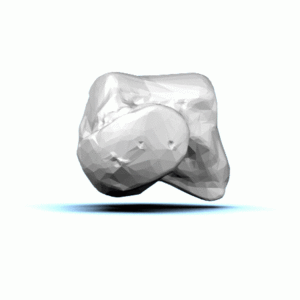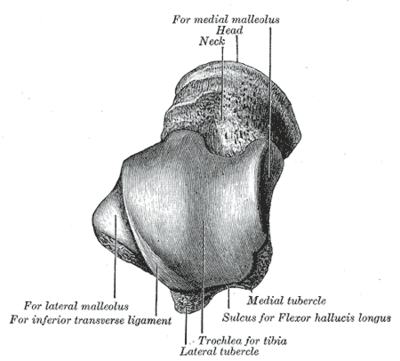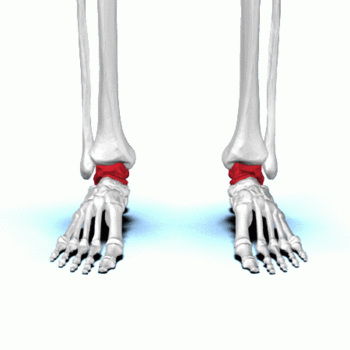Talus: Difference between revisions
No edit summary |
No edit summary |
||
| Line 24: | Line 24: | ||
=== Structure === | === Structure === | ||
[[File:Talus .png|right|frameless]] | [[File:Talus .png|right|frameless|400x400px]] | ||
The talus is an incredible bone; despite its small size, it transmits considerable force during the normal gait cycle and even more significant force during impact activities. | The talus is an incredible bone; despite its small size, it transmits considerable force during the normal gait cycle and even more significant force during impact activities. | ||
* The talus is shaped like a truncated cone and is wider anteriorly than posteriorly. | * The talus is shaped like a truncated cone and is wider anteriorly than posteriorly (it is an irregular saddle-shaped bone). | ||
* Approximately two-thirds of its surface area is covered with articular cartilage and it has a tenuous blood supply, similar to the scaphoid. | * Approximately two-thirds of its surface area is covered with articular [[cartilage]] and it has a tenuous blood supply, similar to the [[scaphoid]]. | ||
* The talus has seven articular surfaces and is divided into the head, neck and body, and two processes, the posterior process and the lateral process ( | * The talus has seven articular surfaces and is divided into the head, neck and body, and two processes, the posterior process and the lateral process | ||
* The | * The talar body has a curved smooth trochlear surface also termed the talar dome, which is covered with hyaline cartilage and convex from front to back. The medial and lateral surfaces articulate with the medial malleolus (of the tibia) and lateral malleolus (of the fibula) respectively. The lateral articular surface is large and projects more inferiorly. The lower part of the lateral surface forms a bony projection called the lateral process which supports the lower portion of the lateral articular facet. The posterior aspect has a backward and medially facing posterior process, which has a lateral and medial tubercle separated by a groove for the tendon of [[flexor hallucis longus]]. | ||
*The talar head is the part that articulates with the navicular bone. On its inferior aspect, this is continuous with three articular facets that are separated by smooth ridges. There are anterior and middle facets which articulate with corresponding facets on the calcaneus. There is another facet, medial to the above facets, for articulation with the [[Spring Ligament|spring]] ligament. The talar head and body are connected by the talar neck, which is inclined downwards distally and medially..<ref>Majeed H, McBride DJ. [https://www.ncbi.nlm.nih.gov/pmc/articles/PMC5890124/ Talar process fractures: an overview and update of the literature]. EFORT open reviews. 2018 Mar;3(3):85-92. Available from:https://www.ncbi.nlm.nih.gov/pmc/articles/PMC5890124/ (last accessed 11.3.2020)</ref> | |||
* The inferior surface of the talar neck has a deep groove, the sulcus tali, that passes obliquely forward and expands from medial to lateral. It forms the tarsal sinus with the calcaneal sulcus of the [[Calcaneal Fractures|calcaneum]]. <ref name=":1">Radiopedia [https://radiopaedia.org/articles/talus Talus] Available from:https://radiopaedia.org/articles/talus (last accessed 12.3.2020)</ref> | |||
== Function == | == Function == | ||
| Line 35: | Line 37: | ||
=== Articulations === | === Articulations === | ||
* superiorly through the talar dome to form the mortise joint of the ankle with the [[tibia]] and [[fibula]] | |||
* inferoposteriorly: large oblique facet that is concave articulates with the calcaneus to form the talocalcaneal joint | |||
* anteroinferiorly: two facets for articulation with the calcaneus to form part of the talocalcaneonavicular joint | |||
* talar head (domed articular surface) with the navicular bone (circular depression on the posterior surface)<ref name=":1" /> | |||
=== Muscle attachments === | === Muscle attachments === | ||
| Line 40: | Line 46: | ||
* If there is vascular compromise to the talus through traumatic injuries such as in the setting of displaced fractures, there is a relatively high risk of developing post-traumatic, avascular necrosis (AVN)<ref name=":0" /> | * If there is vascular compromise to the talus through traumatic injuries such as in the setting of displaced fractures, there is a relatively high risk of developing post-traumatic, avascular necrosis (AVN)<ref name=":0" /> | ||
== | == Ligaments == | ||
* anterior talofibular ligament | |||
* posterior talofibular ligament | |||
* talocalcaneal ligaments | |||
* tarsal sinus ligaments | |||
** cervical ligament | |||
** talocalcaneal interosseous ligament | |||
* deltoid ligament | |||
** anterior tibiotalar ligament | |||
** posterior superficial tibiotalar ligament | |||
** posterior deep tibiotalar ligament | |||
* dorsal talonavicular ligament<ref name=":1" /> | |||
== | == Blood Supply == | ||
* posterior tibial artery into the medial side of body and sinus | |||
* anterior tibial artery/dorsalis pedis artery into head and neck | |||
* peroneal artery into the lateral side of the body and sinus<ref name=":1" /> | |||
=== Innervation === | |||
* deep peroneal nerve | |||
* tibial nerve | |||
* saphenous nerve | |||
* sural nerves<ref name=":1" /> | |||
== Clinical Significance == | |||
'''Avascular necrosis (AVN):''' | |||
Fractures of the talus have a high risk of developing AVN due to its inherently tenuous and limited blood supply. | |||
* Talar fractures make up one percent of all foot and ankle fractures, and the most common (around 50%) talar fractures occur in the talar neck, the weakest part of the talus.<ref name=":0" /> | |||
* Talar body fractures make up 20% of all talar fractures, and if a fracture extends through an articulating surface on the talar body, sequelae of osteoarthritis can occur. | |||
'''Avulsion Fractures of the Talus:''' | |||
Lateral ankle sprains are the most common athletic injury, constituting 15 to 20% of all athletic injuries, and 85% of all ankle sprains. | |||
* Due to the attachment of the ATFL and PTFL on the talus, avulsion fractures of the talus may occur when those ligaments suffer injury in lateral ankle sprains. | |||
* One percent of all ankle sprains cause avulsion fractures of the talus, so it’s important to consider them in the differential diagnosis when patients present with symptoms a lateral ankle sprain, especially if patients have marked swelling, bruising, or difficulty weight-bearing. | |||
'''Tarsal Tunnel Syndrome:''' | |||
Located on the ankle's medial aspect, the tarsal tunnel forms a bony floor consisting of the tibia, talus, and calcaneus, and a fibrous roof consisting of the fibrous flexor retinaculum. | |||
[[Tarsal Tunnel syndrome|Tarsal tunnel syndrome]]. The posterior tibial nerve, artery, vein, and posterior tibialis, flexor hallicus longus, and flexor digitorum longus tendons are inside of the tarsal tunnel, and the posterior tibial nerve has the potential to become entrapped within the space | |||
* Characterized by pain, paresthesia, loss of sensation over the medial foot and ankle, patients may also experience weakness and muscle atrophy in severe cases. | |||
* Bony lesions on the talus, such as osteophytes or osteosarcoma, may cause the posterior tibial nerve to get compressed in the tarsal tunnel, leading to tarsal tunnel syndrome. | |||
Pes Planus: | |||
Through the subtalar joint, the talus maintains the medial and lateral longitudinal arches. When there is an alteration of talus morphology of the articular facets, the biomechanics of the subtalar joint change, which can lead to pes planus. <ref name=":0" /> | |||
== Treatment == | == Treatment == | ||
Revision as of 07:10, 12 March 2020
This article or area is currently under construction and may only be partially complete. Please come back soon to see the finished work! (12/03/2020)
Original Editor
Top Contributors - Lucinda hampton, Ewa Jaraczewska, Kim Jackson and Vidya Acharya
Introduction[edit | edit source]
The talus is the second largest bone in the hindfoot region of the human body. Responsible for transmitting body weight and forces passing between the lower leg and the foot.
The Talus (left talus shown in image)
- Is a component of many multiple joints, including the talocrural (ankle), subtalar, and transverse tarsal joints.
- Does not have any direct muscular attachments and has a tenuous and limited blood supply,
- Serves as the site of attachment for many ligaments including the lateral ankle ligaments and medial deltoid ligament complex.
Talus fractures comprise about 1% of all foot and ankle fractures.
Nearly 70% of ankle injuries can cause varying degrees of chondral and osteochondral injuries to the talus.
It is important to be aware of the occurrence of both isolated and associated talar injuries and their extent of clinical and potentially long-term implications.[1]
Structure[edit | edit source]
The talus is an incredible bone; despite its small size, it transmits considerable force during the normal gait cycle and even more significant force during impact activities.
- The talus is shaped like a truncated cone and is wider anteriorly than posteriorly (it is an irregular saddle-shaped bone).
- Approximately two-thirds of its surface area is covered with articular cartilage and it has a tenuous blood supply, similar to the scaphoid.
- The talus has seven articular surfaces and is divided into the head, neck and body, and two processes, the posterior process and the lateral process
- The talar body has a curved smooth trochlear surface also termed the talar dome, which is covered with hyaline cartilage and convex from front to back. The medial and lateral surfaces articulate with the medial malleolus (of the tibia) and lateral malleolus (of the fibula) respectively. The lateral articular surface is large and projects more inferiorly. The lower part of the lateral surface forms a bony projection called the lateral process which supports the lower portion of the lateral articular facet. The posterior aspect has a backward and medially facing posterior process, which has a lateral and medial tubercle separated by a groove for the tendon of flexor hallucis longus.
- The talar head is the part that articulates with the navicular bone. On its inferior aspect, this is continuous with three articular facets that are separated by smooth ridges. There are anterior and middle facets which articulate with corresponding facets on the calcaneus. There is another facet, medial to the above facets, for articulation with the spring ligament. The talar head and body are connected by the talar neck, which is inclined downwards distally and medially..[2]
- The inferior surface of the talar neck has a deep groove, the sulcus tali, that passes obliquely forward and expands from medial to lateral. It forms the tarsal sinus with the calcaneal sulcus of the calcaneum. [3]
Function[edit | edit source]
Articulations[edit | edit source]
- superiorly through the talar dome to form the mortise joint of the ankle with the tibia and fibula
- inferoposteriorly: large oblique facet that is concave articulates with the calcaneus to form the talocalcaneal joint
- anteroinferiorly: two facets for articulation with the calcaneus to form part of the talocalcaneonavicular joint
- talar head (domed articular surface) with the navicular bone (circular depression on the posterior surface)[3]
Muscle attachments[edit | edit source]
The talus does not serve as the site of any muscle attachment, which is significant because that means the talus does not have secondary sources of blood supply.
- If there is vascular compromise to the talus through traumatic injuries such as in the setting of displaced fractures, there is a relatively high risk of developing post-traumatic, avascular necrosis (AVN)[1]
Ligaments[edit | edit source]
- anterior talofibular ligament
- posterior talofibular ligament
- talocalcaneal ligaments
- tarsal sinus ligaments
- cervical ligament
- talocalcaneal interosseous ligament
- deltoid ligament
- anterior tibiotalar ligament
- posterior superficial tibiotalar ligament
- posterior deep tibiotalar ligament
- dorsal talonavicular ligament[3]
Blood Supply[edit | edit source]
- posterior tibial artery into the medial side of body and sinus
- anterior tibial artery/dorsalis pedis artery into head and neck
- peroneal artery into the lateral side of the body and sinus[3]
Innervation[edit | edit source]
- deep peroneal nerve
- tibial nerve
- saphenous nerve
- sural nerves[3]
Clinical Significance[edit | edit source]
Avascular necrosis (AVN):
Fractures of the talus have a high risk of developing AVN due to its inherently tenuous and limited blood supply.
- Talar fractures make up one percent of all foot and ankle fractures, and the most common (around 50%) talar fractures occur in the talar neck, the weakest part of the talus.[1]
- Talar body fractures make up 20% of all talar fractures, and if a fracture extends through an articulating surface on the talar body, sequelae of osteoarthritis can occur.
Avulsion Fractures of the Talus:
Lateral ankle sprains are the most common athletic injury, constituting 15 to 20% of all athletic injuries, and 85% of all ankle sprains.
- Due to the attachment of the ATFL and PTFL on the talus, avulsion fractures of the talus may occur when those ligaments suffer injury in lateral ankle sprains.
- One percent of all ankle sprains cause avulsion fractures of the talus, so it’s important to consider them in the differential diagnosis when patients present with symptoms a lateral ankle sprain, especially if patients have marked swelling, bruising, or difficulty weight-bearing.
Tarsal Tunnel Syndrome:
Located on the ankle's medial aspect, the tarsal tunnel forms a bony floor consisting of the tibia, talus, and calcaneus, and a fibrous roof consisting of the fibrous flexor retinaculum.
Tarsal tunnel syndrome. The posterior tibial nerve, artery, vein, and posterior tibialis, flexor hallicus longus, and flexor digitorum longus tendons are inside of the tarsal tunnel, and the posterior tibial nerve has the potential to become entrapped within the space
- Characterized by pain, paresthesia, loss of sensation over the medial foot and ankle, patients may also experience weakness and muscle atrophy in severe cases.
- Bony lesions on the talus, such as osteophytes or osteosarcoma, may cause the posterior tibial nerve to get compressed in the tarsal tunnel, leading to tarsal tunnel syndrome.
Pes Planus:
Through the subtalar joint, the talus maintains the medial and lateral longitudinal arches. When there is an alteration of talus morphology of the articular facets, the biomechanics of the subtalar joint change, which can lead to pes planus. [1]
Treatment[edit | edit source]
Resources[edit | edit source]
References[edit | edit source]
- ↑ 1.0 1.1 1.2 1.3 Irfan A. Khan; Matthew Varacallo. Anatomy, Bony Pelvis and Lower Limb, Foot Talus ☀April 21, 2019. Available from: ☀https://www.ncbi.nlm.nih.gov/books/NBK541086/ (last accessed 11.3.2020)
- ↑ Majeed H, McBride DJ. Talar process fractures: an overview and update of the literature. EFORT open reviews. 2018 Mar;3(3):85-92. Available from:https://www.ncbi.nlm.nih.gov/pmc/articles/PMC5890124/ (last accessed 11.3.2020)
- ↑ 3.0 3.1 3.2 3.3 3.4 Radiopedia Talus Available from:https://radiopaedia.org/articles/talus (last accessed 12.3.2020)









